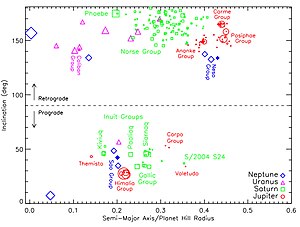Irregular moon
The term does not refer to shape; Triton, for example, is a round moon but is considered irregular due to its orbit and origins.As of February 2024[update], 228 irregular moons are known, orbiting all four of the outer planets (Jupiter, Saturn, Uranus, and Neptune).It is currently thought that the irregular satellites were once independent objects orbiting the Sun before being captured by a nearby planet, early in the history of the Solar System.An alternative suggests that they originated further out in the Kuiper belt[1] and were captured after the close flyby of another star[2] There is no widely accepted precise definition of an irregular satellite.(Indeed, it appears that the irregular moons of the giant planets, the Jovian and Neptunian trojans, and grey Kuiper belt objects have a similar origin.[7]).[8] For this to occur, at least one of three things needs to have happened: After the capture, some of the satellites could break up leading to groupings of smaller moons following similar orbits.The satellites enter the zone of the regular (larger) moons and are lost or ejected via collision and close encounters.[10] The asymmetry between the prograde and retrograde satellites can be explained very intuitively by the Coriolis acceleration in the frame rotating with the planet.[15][16][17] Because objects of a given size are more difficult to see the greater their distance from Earth, the known irregular satellites of Uranus and Neptune are larger than those of Jupiter and Saturn; smaller ones probably exist but have not yet been observed.Bearing this observational bias in mind, the size distribution of irregular satellites appears to be similar for all four giant planets.An analysis of images taken by the Canada-France-Hawaii Telescope in 2010 shows that the power law for Jupiter's population of small retrograde satellites, down to a detection limit of ≈ 400 m, is relatively shallow, at q ≃ 2.5.[citation needed] Regular satellites are usually tidally locked (that is, their orbit is synchronous with their rotation so that they only show one face toward their parent planet).Dynamical groupings of irregular satellites can be identified using these criteria and the likelihood of the common origin from a break-up evaluated.[22] When the dispersion of the orbits is too wide (i.e. it would require Δv in the order of hundreds of m/s) When the colours and spectra of the satellites are known, the homogeneity of these data for all the members of a given grouping is a substantial argument for a common origin.The table at right shows the minimum radius (rmin) of satellites that can be detected with current technology, assuming an albedo of 0.04; thus, there are almost certainly small Uranian and Neptunian moons that cannot yet be seen.[25] However, these groupings are not directly supported by the observed colours: Caliban and Sycorax appear light red, whereas the smaller moons are grey.Throughout the Cassini mission, many Saturnian irregulars were observed from a distance: Albiorix, Bebhionn, Bergelmir, Bestla, Erriapus, Fornjot, Greip, Hati, Hyrrokkin, Ijiraq, Kari, Kiviuq, Loge, Mundilfari, Narvi, Paaliaq, Siarnaq, Skathi, Skoll, Suttungr, Tarqeq, Tarvos, Thrymr, and Ymir.[5] The Tianwen-4 mission (to launch 2029) is planned to focus on the regular moon Callisto around Jupiter, but it may fly-by several irregular Jovian satellites before settling into Callistonian orbit.




Jupiter · Himalia · Callisto



Asteroid capturePhoebeTritonastronomynatural satelliteinclinedhighly ellipticalretrograderegular satellitestemporary satellitesround moonouter planetsJupiterSaturnUranusNeptuneHimaliaSycoraxNereidKuiper belt106 kmorbital planesemi-major axisHill sphereapoapsesIapetusorbital inclinationRetrograde orbitsPasiphaeosculating elementsproper orbital elementsfamilies of asteroidsJovianNeptunian trojanstrans-neptunian objectspassing starthree-body interactionResonancesapocentersecularKozai resonanceCoriolis accelerationframe rotating2006 RH1202020 CD3power lawCanada-France-Hawaii TelescopecentaurPholusclassical Kuiper belt objectscolour indicesapparent magnitudefiltersalbedoD-type asteroidsCalibanProsperoSetebosHalimedesynchronousasteroidscollisional familiesorbital eccentricityProgradeHimalia groupC-type asteroidsinfraredThemistoValetudoCarme groupD-type asteroidAnanke groupAnankePasiphae groupCallirrhoeMegacliteSinopesecular resonancesGallic groupInuit groupNorse groupSkathiKiviuqIjiraqPaaliaqSiarnaqTarqeqradiusPsamatheVoyager 2CassiniNew HorizonsAlbiorixBebhionnBergelmirBestlaErriapusFornjotHyrrokkinMundilfariSuttungrTarvosThrymrTianwen-4BibcodeJet Propulsion LaboratoryTrujillo, C. A.Minor Planet CenterGladman, BrettHolman, Matthew J.The Astrophysical JournalSheppard, Scott S.Jewitt, David C.Kleyna, JanHolman, M. J.Kavelaars, J. J.Natural satellitesSolar SystemPlanetarysatellitesDwarf planetsatellitesHaumeaQuaoarMakemakeGonggongMinor-planetmoonsFlorence